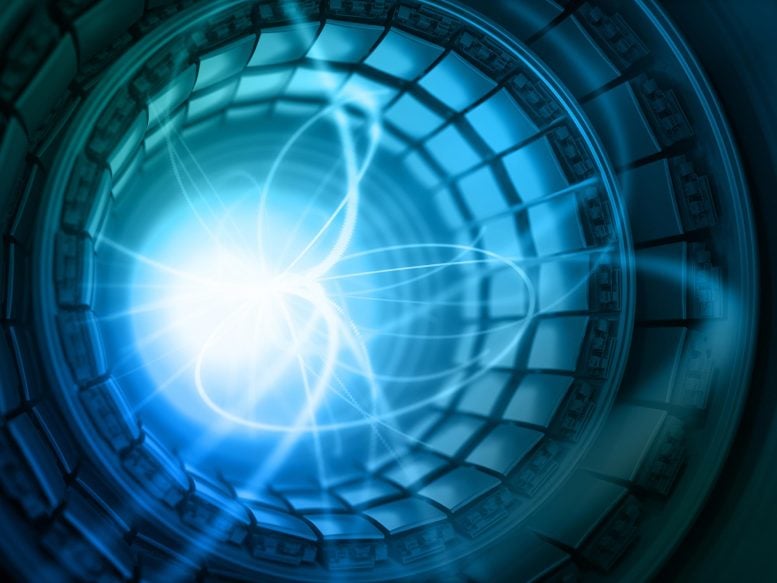
Four complementary analyses released by the international MicroBooNE collaboration all confirm the absence of the sterile neutrino.
The theoretical particle known as the sterile neutrino has been dealt a blow by new results from the MicroBooNE experiment at the U.S. Department of Energy’s Fermi National Accelerator Laboratory. For more than two decades, this proposed fourth neutrino has remained a promising explanation for anomalies seen in earlier physics experiments. Finding a new particle would be a major discovery and a radical shift in our understanding of the universe.
However, four complementary analyses released by the international MicroBooNE collaboration and presented during a seminar today all show the same thing: no sign of the sterile neutrino. Instead, the results align with the Standard Model of Particle Physics, scientists’ best theory of how the universe works. The data is consistent with what the Standard Model predicts: three kinds of neutrinos—no more, no less.
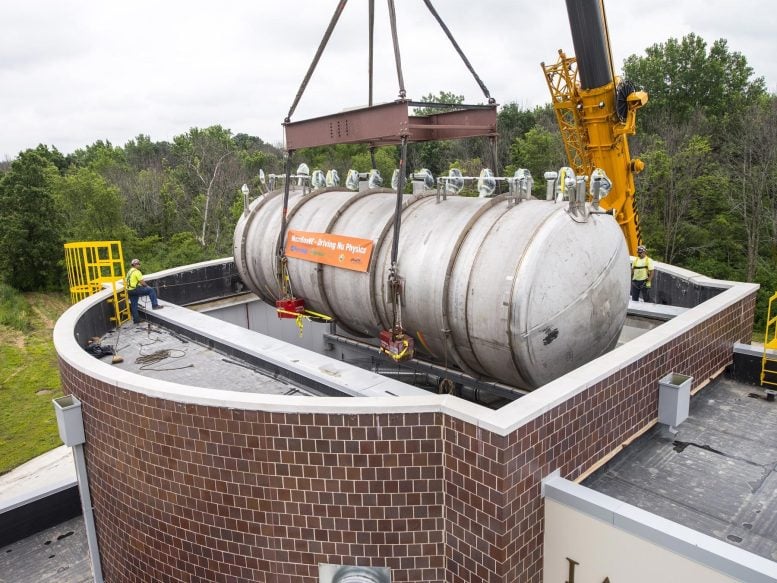
The international MicroBooNE experiment uses a 170-ton detector placed in Fermilab’s neutrino beam. The experiment studies neutrino interactions and has found no hint of a theorized fourth neutrino called the sterile neutrino. Credit: Reidar Hahn, Fermilab.
“MicroBooNE has made a very comprehensive exploration through multiple types of interactions, and multiple analysis and reconstruction techniques,” said Bonnie Fleming, physics professor at Yale University and co-spokesperson for MicroBooNE. “They all tell us the same thing, and that gives us very high confidence in our results that we are not seeing a hint of a sterile neutrino.”
MicroBooNE is a 170-ton neutrino detector roughly the size of a school bus that has operated since 2015. The international experiment has close to 200 collaborators from 36 institutions in five countries. They used cutting-edge technology to record spectacularly precise 3D images of neutrino events and examine particle interactions in detail—a much-needed probe into the subatomic world.
Neutrinos are one of the fundamental particles in nature. They’re neutral, incredibly tiny, and the most abundant particle with mass in our universe—though they rarely interact with other matter. They’re also particularly intriguing to physicists, with a number of unanswered questions surrounding them. These puzzles include why their masses are so vanishingly small and whether they are responsible for matter’s dominance over antimatter in our universe. This makes neutrinos a unique window into exploring how the universe works at the smallest scales.
MicroBooNE’s new results are an exciting turning point in neutrino research. With sterile neutrinos further disfavored as the explanation for anomalies spotted in neutrino data, scientists are investigating other possibilities. These include things as intriguing as light created by other processes during neutrino collisions or as exotic as dark matter, unexplained physics related to the Higgs boson, or other physics beyond the Standard Model.
First hints of sterile neutrinos
Neutrinos come in three known types—the electron, muon, and tau neutrino—and can switch between these flavors in a particular way as they travel. This phenomenon is called “neutrino oscillation.” Scientists can use their knowledge of oscillations to predict how many neutrinos of any kind they expect to see when measuring them at various distances from their source.
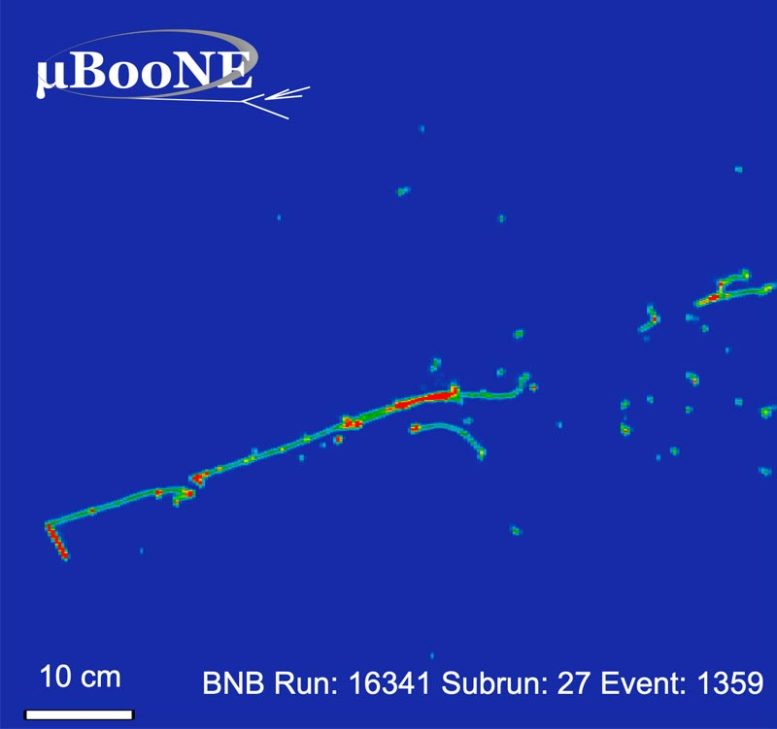
MicroBooNE’s advanced liquid argon technology enables researchers to capture detailed images of particle tracks. This electron neutrino event shows an electron shower and a proton track. Credit: MicroBooNE collaboration
Neutrinos are produced by many sources, including the sun, the atmosphere, nuclear reactors and particle accelerators. Starting around two decades ago, data from two particle beam experiments threw researchers for a loop.
In the 1990s, the Liquid Scintillator Neutrino Detector experiment at DOE’s Los Alamos National Laboratory saw more particle interactions than expected. In 2002, the follow-up MiniBooNE experiment at Fermilab began gathering data to investigate the LSND result in more detail.
MiniBooNE scientists also saw more particle events than calculations predicted. These strange neutrino beam results were followed by reports of missing electron neutrinos from radioactive sources and reactor neutrino experiments.
Sterile neutrinos emerged as a popular candidate to explain these odd results. While neutrinos are already tricky to detect, the proposed sterile neutrino would be even more elusive, responding only to the force of gravity. But because neutrinos flit between the different types, a sterile neutrino could impact the way neutrinos oscillate, leaving its signature in the data.
But studying the smallest things in nature isn’t straightforward. Scientists never see neutrinos directly; instead, they see the particles that emerge when a neutrino hits an atom inside a detector.
The MiniBooNE detector had a particular limitation: It was unable to tell the difference between electrons and photons (particles of light) close to where the neutrino interacted. This ambiguity painted a muddled picture of what particles were emerging from collisions. You can think of it like having a box of chocolates—MiniBooNE could tell you it contains a dozen pieces, but MicroBooNE could tell you which ones have almonds, and which have caramel.
If MiniBooNE were truly seeing more electrons than predicted, it would indicate extra electron neutrinos causing the interactions. That would mean something unexpected was happening in the oscillations that researchers hadn’t accounted for: sterile neutrinos. But if photons were causing the excess, it would likely be a background process rather than oscillations gone wild and a new particle.
It was clear that researchers needed a more nuanced detector. In 2007, the idea for MicroBooNE was born.
MicroBooNE: precision detector
The MicroBooNE detector is built on state-of-the-art techniques and technology. It uses special light sensors and more than 8,000 painstakingly attached wires to capture particle tracks. It’s housed in a 40-foot-long cylindrical container filled with 170 tons of pure liquid argon. Neutrinos bump into the dense, transparent liquid, releasing additional particles that the electronics can record. The resulting pictures show detailed particle paths and, crucially, distinguish electrons from photons.
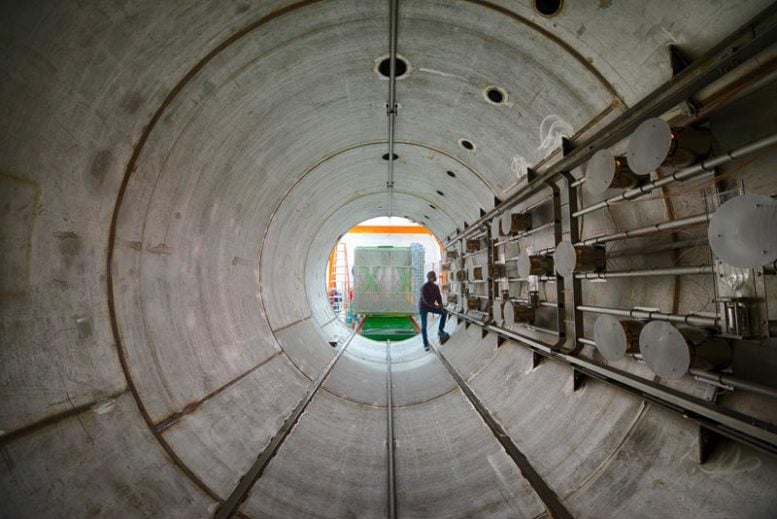
Workers install a component of MicroBooNE’s precision detector (called a time projection chamber) into the cylindrical container, or cryostat. Credit: Reidar Hahn, Fermilab.
MicroBooNE’s first three years of data show no excess of electrons—but they also show no excess of photons from a background process that might indicate an error in MiniBooNE’s data.
“We’re not seeing what we would have expected from a MiniBooNE-like signal, neither electrons nor the most likely of the photon suspects,” said Fermilab scientist Sam Zeller, who served as MicroBooNE co-spokesperson for eight years. “But that earlier data from MiniBooNE doesn’t lie. There’s something really interesting happening that we still need to explain.”
MicroBooNE ruled out the most likely source of photons as the cause of MiniBooNE’s excess events with 95% confidence and ruled out electrons as the sole source with greater than 99% confidence, and there is more to come.
MicroBooNE still has half of its data to analyze and more ways yet to analyze it. The granularity of the detector enables researchers to look at particular kinds of particle interactions. While the team started with the most likely causes for the MiniBooNE excess, there are additional channels to investigate—such as the appearance of an electron and positron, or different outcomes that include photons.
“Being able to look in detail at these different event outcomes is a real strength of our detector,” Zeller said. “The data is steering us away from the likely explanations and pointing toward something more complex and interesting, which is really exciting.”
While the first analyses weighed in on the sterile neutrino, additional analyses could provide more information about exotic explanations, including dark matter, axion-like particles, the hypothetical Z-prime boson, and beyond. There’s even a chance it could still be a sterile neutrino, hiding in even more unexpected ways.
Future neutrino exploration
Neutrinos are surrounded by mysteries. The anomalous data seen by the earlier MiniBooNE and LSND experiments still need an explanation. So too does the very phenomenon of neutrino oscillation and the fact that neutrinos have mass, neither of which is predicted by the Standard Model. There are also tantalizing hints that neutrinos could help explain why there is so much matter in the universe, as opposed to a universe full of antimatter or nothing at all.
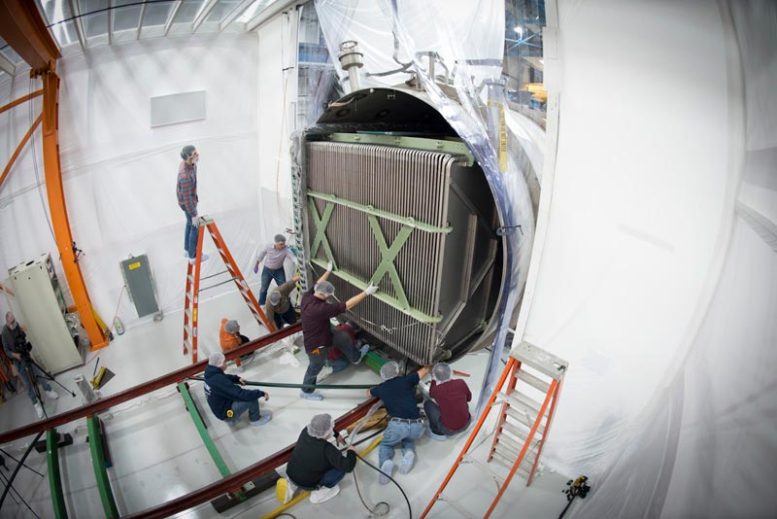
The team inserts the time-projection chamber into the MicroBooNE cryostat. Credit: Reidar Hahn, Fermilab
MicroBooNE is one of a suite of neutrino experiments searching for answers. Crucially, it’s also a long-running testbed for the liquid argon technology that will be used in upcoming detectors.
“We’ve built and tested the hardware, and we’ve also developed the infrastructure to process our enormous dataset,” said Justin Evans, a scientist at the University of Manchester and MicroBooNE co-spokesperson. “That includes the simulations, calibrations, reconstruction algorithms, analysis strategies, and automation through techniques like machine learning. This groundwork is essential for future experiments.”
Liquid argon is the material of choice for the ICARUS detector set to begin gathering physics data soon and the Short-Baseline Near Detector coming online in 2023. Together with MicroBooNE, the three experiments form the Short-Baseline Neutrino Program at Fermilab and will produce a wealth of neutrino data. For example, in one month, SBND will record more data than MicroBooNE collected in two years. Today’s results from MicroBooNE will help guide some of the research in the trio’s broad portfolio.
“Every time we look at neutrinos, we seem to find something new or unexpected,” said Evans. “MicroBooNE’s results are taking us in a new direction, and our neutrino program is going to get to the bottom of some of these mysteries.”
Liquid argon will also be used in the Deep Underground Neutrino Experiment, a flagship international experiment hosted by Fermilab that already has more than 1,000 researchers from over 30 countries. DUNE will study oscillations by sending neutrinos 800 miles (1,300 km) through the earth to detectors at the mile-deep Sanford Underground Research Facility. The combination of short- and long-distance neutrino experiments will give researchers insights into the workings of these fundamental particles.
“We have some big, unanswered questions in physics that many experiments are trying to address,” Fleming said. “And neutrinos may be telling us where to find some of those answers. I think if you want to understand how the universe works, you have to understand neutrinos.”
References:
“Search for Neutrino-Induced Neutral Current Δ Radiative Decay in MicroBooNE and a First Test of the MiniBooNE Low Energy Excess Under a Single-Photon Hypothesis” by MicroBooNE collaboration: P. Abratenko, R. An, J. Anthony, L. Arellano, J. Asaadi, A. Ashkenazi, S. Balasubramanian, B. Baller, C. Barnes, G. Barr, V. Basque, L. Bathe-Peters, O. Benevides Rodrigues, S. Berkman, A. Bhanderi, A. Bhat, M. Bishai, A. Blake, T. Bolton, J.Y. Book, L. Camilleri, D. Caratelli, I. Caro Terrazas, R. Castillo Fernandez, F. Cavanna, G. Cerati, Y. Chen, D. Cianci, J.M. Conrad, M. Convery, L. Cooper-Troendle, J.I. Crespo-Anadon, M. Del Tutto, S.R. Dennis, P. Detje, A. Devitt, R. Diurba, R. Dorrill, K. Duffy, S. Dytman, B. Eberly, A. Ereditato, J.J. Evans, R. Fine, G.A. Fiorentini Aguirre, R.S. Fitzpatrick, B.T. Fleming, N. Foppiani, D. Franco, A.P. Furmanski, D. Garcia-Gamez, S. Gardiner, G. Ge, S. Gollapinni, O. Goodwin, E. Gramellini, P. Green, H. Greenlee, W. Gu, R. Guenette, P. Guzowski, L. Hagaman, O. Hen, C. Hilgenberg, G.A. Horton-Smith, A. Hourlier, R. Itay, C. James, X. Ji, L. Jiang, J.H. Jo, R.A. Johnson, Y.J. Jwa, D. Kalra, N. Kamp, N. Kaneshige, G. Karagiorgi, W. Ketchum, M. Kirby, T. Kobilarcik, I. Kreslo, R. LaZur, I. Lepetic, K. Li, Y. Li, K. Lin, B.R. Littlejohn, W.C. Louis, X. Luo, K. Manivannan, C. Mariani, D. Marsden, J. Marshall, D.A. Martinez Caicedo, K. Mason, A. Mastbaum, N. McConkey, V. Meddage, T. Mettler , K. Miller, J. Mills, K. Mistry, T. Mohayai, A. Mogan, J. Moon, M. Mooney, A.F. Moor, C.D. Moore, L. Mora Lepin, J. Mousseau, M. Murphy, D. Naples, A. Navrer-Agasson, M. Nebot-Guinot, R.K. Neely, D.A. Newmark, J. Nowak, M. Nunes, O. Palamara, V. Paolone, A. Papadopoulou, V. Papavassiliou, S.F. Pate, N. Patel, A. Paudel, Z. Pavlovic, E. Piasetzky, I. Ponce-Pinto, S. Prince, X. Qian, J.L. Raaf, V. Radeka, A. Rafique, M. Reggiani-Guzzo, L. Ren, L.C.J. Rice, L. Rochester, J. Rodriguez Rondon, M. Rosenberg, M. Ross-Lonergan, G. Scanavini, D.W. Schmitz, A. Schukraft, W. Seligman, M.H. Shaevitz, R. Sharankova, J. Shi, J. Sinclair, A. Smith, E.L. Snider, M. Soderberg, S. Soldner-Rembold, P. Spentzouris, J. Spitz, M. Stancari, J. St. John, T. Strauss, K. Sutton, S. Sword-Fehlberg, A.M. Szelc, W. Tang, K. Terao, C.Thorpe, D. Totani, M. Toups, Y.-T. Tsai, M.A. Uchida, T. Usher, W. Van De Pontseele, B. Viren, M. Weber, H. Wei, Z. Williams, S. Wolbers, T. Wongjirad, M. Wospakrik, K. Wresilo, N. Wright, W. Wu, E. Yandel, T. Yang, G. Yarbrough, L.E. Yates, H.W. Yu, G.P. Zeller, J. Zennamo and C. Zhang, 14 March 2022, Physical Review Letters.
DOI: 10.1103/PhysRevLett.128.111801
arXiv:2110.00409
“Search for an anomalous excess of charged-current quasi-elastic νe interactions with the MicroBooNE experiment using Deep-Learning-based reconstruction” by MicroBooNE collaboration, 13 June 2022, Physical Review D.
DOI: 10.1103/PhysRevD.105.112003
arXiv:2110.14080
“Search for an anomalous excess of charged-current νe interactions without pions in the final state with the MicroBooNE experiment” by MicroBooNE collaboration, 13 June 2022, Physical Review D.
DOI: 10.1103/PhysRevD.105.112004
arXiv:2110.14065
“Search for an anomalous excess of inclusive charged-current νe interactions in the MicroBooNE experiment using Wire-Cell reconstruction” by MicroBooNE collaboration, 13 June 2022, Physical Review D.
DOI: 10.1103/PhysRevD.105.112005
arXiv:2110.13978


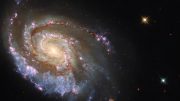
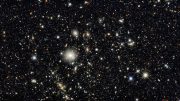
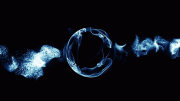

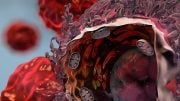

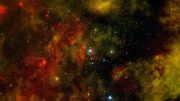
The total Mass & Energy of the universe is constant.So by any of undergoing process in Universe there no loss of mass/energy.In other words sterile neutrino does not exists.Moreover we can speak that physical processes are limited among certain particles.Hence,hypothetic
sterile neutrino is excluded from the well defined rules of Physics on which Universe works.
The MiniBooNE detector had a particular limitation: It was unable to tell the difference between electrons and photons (particles of light) close to where the neutrino interacted. This ambiguity painted a muddled picture of what particles were emerging from collisions. You can think of it like having a box of chocolates—MiniBooNE could tell you it contains a dozen pieces, but MicroBooNE could tell you which ones have almonds, and which have caramel.
did you try looking under the
ultra violet spectrum the mullach abu boone
100
145 ozone
vacuum uv
200
short wave uv uvc
254 germicidal
280
middle wave uv uvb
315
long wave uv uva
400
this one might tell you which one is a halloween trick me neutral neutrino and which one is a halloween treat me neutral neutrino
i prefer the hazelnuts myself a total differnt category of particle physics
smaller than smaller small
i forgot to mention this halloween samhain time they will glow in the ultra violet light the tiny ones you want to see
like teeth and bones at a disco this hall of owen night
There are only two neutrinos. Neutrinos which bind charge and anti neutrinos which un bind charge.
The three “generations” are the neutrino rotating in time and showing its three facets, one for each of the axes which it was bound to. An electrostatic and electric and a magnetic face for each of the EM planes
Remembering high school haha science, neutrinos are a by-product of the hole. Thats right the 🕳 hole. Bang!!!!!!!In and out everywhere but less than ele,pro,pho,anti or matter, Mason boson or even quarks. Neutrino seen in argon only. Hint;););) but have mass silly me ,my hand was up in the mythology of physics, Albert Einstein might agree or not. Cooling down in time.
… now, there is some thing that might propel the spread of the Universe and it is called the Dark energy.
But, what if the Universe has sprang into existence and somehow that was some resonant frequency of the space time and we have. Well, the Universe that is getting bigger and bigger which is strange, because it should become smaller and smaller…